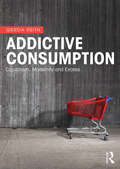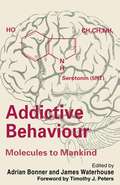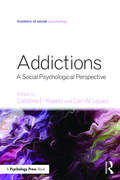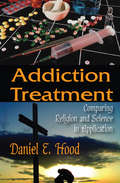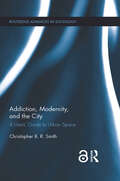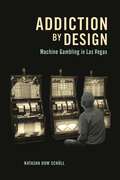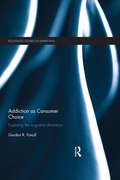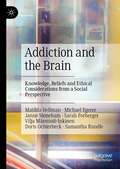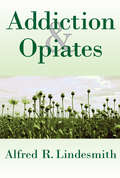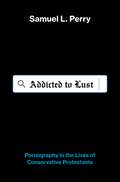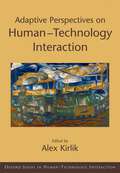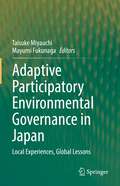- Table View
- List View
Addictive Consumption: Capitalism, Modernity and Excess
by Gerda ReithIn this engaging new book, Gerda Reith explores key theoretical concepts in the sociology of consumption. Drawing on the ideas of Foucault, Marx and Bataille, amongst others, she investigates the ways that understandings of ‘the problems of consumption’ change over time, and asks what these changes can tell us about their wider social and political contexts. Through this, she uses ideas about both consumption and addiction to explore issues around identity and desire, excess and control and reason and disorder. She also assesses how our concept of 'normal' consumption has grown out of efforts to regulate behaviour historically considered as disruptive or deviant, and how in the contemporary world the 'dark side' of consumption has been medicalised in terms of addiction, pathology and irrationality. By drawing on case studies of drugs, food and gambling, the volume demonstrates the ways in which modern practices of consumption are rooted in historical processes and embedded in geopolitical structures of power. It not only asks how modern consumer culture came to be in the form it is today, but also questions what its various manifestations can tell us about wider issues in capitalist modernity. Addictive Consumption offers a compelling new perspective on the origins, development and problems of consumption in modern society. The volume’s interdisciplinary profile will appeal to scholars and students in sociology, psychology, history, philosophy and anthropology.
Addictive Behaviour: Perspectives on the Nature of Addiction
by Adrian Bonner James WaterhouseIn this health-conscious age there is increasing concern about tobacco smoking and inappropriate consumption levels of alcohol. Alcoholism poses an important occupational health problem which can affect an individual's personal welfare and limit his or her efficiency at work. There is concern about the increasing availability of drugs in society, the link between drug-taking and the spread of HIV in society, and the ways in which substance misuse generates more violence within society. Both excessive alcohol consumption and drug-taking may dispose an individual to antisocial actions and lead to criminal activities. By examining the underlying biological and psychological nature of these behaviours the book is intended to inform its readers of current advances in a number of relevant disciplines and to demonstrate some of the problems in collecting and interpreting information from particular groups. 2
Addictions: A Social Psychological Perspective (Frontiers of Social Psychology)
by Catalina E. Kopetz Carl W. LejuezThe current volume brings together social psychological theories and concepts and discusses their relevance to understanding substance use and addiction. It identifies convergence points between traditional perspectives on addiction and social psychological theory and research. This coexistence, which acknowledges the value of the conceptual and methodological advancements in each relevant field and attempts to integrate them, promotes scientific understanding and a more effective prevention and treatment of addiction.
Addictions: A Social Psychological Perspective (Frontiers of Social Psychology)
by Catalina E. Kopetz Carl W. LejuezThe current volume brings together social psychological theories and concepts and discusses their relevance to understanding substance use and addiction. It identifies convergence points between traditional perspectives on addiction and social psychological theory and research. This coexistence, which acknowledges the value of the conceptual and methodological advancements in each relevant field and attempts to integrate them, promotes scientific understanding and a more effective prevention and treatment of addiction.
Addiction Treatment: Comparing Religion and Science in Application
by Daniel HoodAddiction Treatment is an ethnography that compares two types of residential drug-free treatment programs-religious, faith-based programs and science-based, secular programs. Although these programs have originated from significantly different ideological bases, in examining the day-to-day operations of each, Daniel E. Hood concludes that they are far more alike than they are different. Drug-free treatment today, whether in secular or religious form, is little more than a remnant of the temperance movement. It is a warning to stop using drugs. At its best, treatment provides practical advice and support for complete abstinence. At its worst, it demeans users for a form of behavior that is not well understood and threatens death if they do not stop. Hood argues that there is no universal agreement on what addiction is and that drug abuse is little more than a catch-all term of no specific meaning used to condemn behavior that is socially unacceptable. Through extensive participatory observations, intimate life history interviews, and informal conversations with residents and staff, Hood shows how both programs use the same basic techniques of ideological persuasion (mutual witnessing), methods of social control (discourse deprivation), and the same proposed zero tolerance, abstinent lifestyle (Christian living vs. Right living) as they endeavor to transform clients from addicts to citizens or from sinners to disciples.
Addiction Treatment: Comparing Religion and Science in Application
by Daniel E. HoodAddiction Treatment is an ethnography that compares two types of residential drug-free treatment programs-religious, faith-based programs and science-based, secular programs. Although these programs have originated from significantly different ideological bases, in examining the day-to-day operations of each, Daniel E. Hood concludes that they are far more alike than they are different. Drug-free treatment today, whether in secular or religious form, is little more than a remnant of the temperance movement. It is a warning to stop using drugs. At its best, treatment provides practical advice and support for complete abstinence. At its worst, it demeans users for a form of behavior that is not well understood and threatens death if they do not stop. Hood argues that there is no universal agreement on what addiction is and that drug abuse is little more than a catch-all term of no specific meaning used to condemn behavior that is socially unacceptable. Through extensive participatory observations, intimate life history interviews, and informal conversations with residents and staff, Hood shows how both programs use the same basic techniques of ideological persuasion (mutual witnessing), methods of social control (discourse deprivation), and the same proposed zero tolerance, abstinent lifestyle (Christian living vs. Right living) as they endeavor to transform clients from addicts to citizens or from sinners to disciples.
Addiction, Modernity, and the City: A Users’ Guide to Urban Space (Routledge Advances in Sociology)
by Christopher B.R. SmithExamining the interdependent nature of substance, space, and subjectivity, this book constitutes an interdisciplinary analysis of the intoxication indigenous to what has been termed "our narcotic modernity." The first section – Drug/Culture – demonstrates how the body of the addict and the social body of the city are both inscribed by "controlled" substance. Positing addiction as a "pathology (out) of place" that is specific to the (late-)capitalist urban landscape, the second section – Dope/Sick – conducts a critique of the prevailing pathology paradigm of addiction, proposing in its place a theoretical reconceptualization of drug dependence in the terms of "p/re/in-scription." Remapping the successive stages or phases of our narcotic modernity, the third section – Narco/State – delineates three primary eras of narcotic modernity, including the contemporary city of "safe"/"supervised" consumption. Employing an experimental, "intra-textual" format, the fourth section – Brain/Disease – mimics the sense, state or scape of intoxication accompanying each permutation of narcotic modernity in the interchangeable terms of drug, dream and/or disease. Tracing the parallel evolution of "addiction," the (late-)capitalist cityscape, and the pathological project of modernity, the four parts of this book thus together constitute a users’ guide to urban space.
Addiction, Modernity, and the City: A Users’ Guide to Urban Space (Routledge Advances in Sociology)
by Christopher B.R. SmithExamining the interdependent nature of substance, space, and subjectivity, this book constitutes an interdisciplinary analysis of the intoxication indigenous to what has been termed "our narcotic modernity." The first section – Drug/Culture – demonstrates how the body of the addict and the social body of the city are both inscribed by "controlled" substance. Positing addiction as a "pathology (out) of place" that is specific to the (late-)capitalist urban landscape, the second section – Dope/Sick – conducts a critique of the prevailing pathology paradigm of addiction, proposing in its place a theoretical reconceptualization of drug dependence in the terms of "p/re/in-scription." Remapping the successive stages or phases of our narcotic modernity, the third section – Narco/State – delineates three primary eras of narcotic modernity, including the contemporary city of "safe"/"supervised" consumption. Employing an experimental, "intra-textual" format, the fourth section – Brain/Disease – mimics the sense, state or scape of intoxication accompanying each permutation of narcotic modernity in the interchangeable terms of drug, dream and/or disease. Tracing the parallel evolution of "addiction," the (late-)capitalist cityscape, and the pathological project of modernity, the four parts of this book thus together constitute a users’ guide to urban space.
Addiction by Design: Machine Gambling in Las Vegas
by Natasha Dow SchüllRecent decades have seen a dramatic shift away from social forms of gambling played around roulette wheels and card tables to solitary gambling at electronic terminals. Slot machines, revamped by ever more compelling digital and video technology, have unseated traditional casino games as the gambling industry's revenue mainstay. Addiction by Design takes readers into the intriguing world of machine gambling, an increasingly popular and absorbing form of play that blurs the line between human and machine, compulsion and control, risk and reward.Drawing on fifteen years of field research in Las Vegas, anthropologist Natasha Dow Schüll shows how the mechanical rhythm of electronic gambling pulls players into a trancelike state they call the "machine zone," in which daily worries, social demands, and even bodily awareness fade away. Once in the zone, gambling addicts play not to win but simply to keep playing, for as long as possible--even at the cost of physical and economic exhaustion. In continuous machine play, gamblers seek to lose themselves while the gambling industry seeks profit. Schüll describes the strategic calculations behind game algorithms and machine ergonomics, casino architecture and "ambience management," player tracking and cash access systems--all designed to meet the market's desire for maximum "time on device." Her account moves from casino floors into gamblers' everyday lives, from gambling industry conventions and Gamblers Anonymous meetings to regulatory debates over whether addiction to gambling machines stems from the consumer, the product, or the interplay between the two.Addiction by Design is a compelling inquiry into the intensifying traffic between people and machines of chance, offering clues to some of the broader anxieties and predicaments of contemporary life. At stake in Schüll's account of the intensifying traffic between people and machines of chance is a blurring of the line between design and experience, profit and loss, control and compulsion.
Addiction by Design: Machine Gambling in Las Vegas (PDF)
by Natasha Dow SchüllRecent decades have seen a dramatic shift away from social forms of gambling played around roulette wheels and card tables to solitary gambling at electronic terminals. Slot machines, revamped by ever more compelling digital and video technology, have unseated traditional casino games as the gambling industry's revenue mainstay. Addiction by Design takes readers into the intriguing world of machine gambling, an increasingly popular and absorbing form of play that blurs the line between human and machine, compulsion and control, risk and reward.Drawing on fifteen years of field research in Las Vegas, anthropologist Natasha Dow Schüll shows how the mechanical rhythm of electronic gambling pulls players into a trancelike state they call the "machine zone," in which daily worries, social demands, and even bodily awareness fade away. Once in the zone, gambling addicts play not to win but simply to keep playing, for as long as possible--even at the cost of physical and economic exhaustion. In continuous machine play, gamblers seek to lose themselves while the gambling industry seeks profit. Schüll describes the strategic calculations behind game algorithms and machine ergonomics, casino architecture and "ambience management," player tracking and cash access systems--all designed to meet the market's desire for maximum "time on device." Her account moves from casino floors into gamblers' everyday lives, from gambling industry conventions and Gamblers Anonymous meetings to regulatory debates over whether addiction to gambling machines stems from the consumer, the product, or the interplay between the two.Addiction by Design is a compelling inquiry into the intensifying traffic between people and machines of chance, offering clues to some of the broader anxieties and predicaments of contemporary life. At stake in Schüll's account of the intensifying traffic between people and machines of chance is a blurring of the line between design and experience, profit and loss, control and compulsion.
Addiction as Consumer Choice: Exploring the Cognitive Dimension (Routledge Studies in Marketing)
by Gordon FoxallA striking characteristic of addictive behavior is the pursuit of immediate reward at the risk of longer-term detrimental outcomes. It is typically accompanied by the expression of a strong desire to cease from or at least control consumption that has such consequences, followed by lapse, further resolution, relapse, and so on. Understood in this way, addiction includes substance abuse as well as behavioral compulsions like excessive gambling or even uncontrollable shopping. Behavioral economics and neurophysiology provide well-worn paths to understanding this behavior and this book regards them as central components of this quest. However, the specific question it seeks to answer is, What part does cognition – the desires we pursue and the beliefs we have about how to accomplish them – play in explaining addictive behavior? The answer is sought in a methodology that indicates why and where cognitive explanation is necessary, the form it should take, and the outcomes of employing it to understand addiction. It applies the Behavioral Perspective Model (BPM) of consumer choice, a tried and tested theory of more routine consumption, ranging from everyday product and brand choice, through credit purchasing and environmental despoliation, to the more extreme aspects of consumption represented by compulsion and addiction. The book will advance debate among behavioral scientists, cognitive psychologists, and other professionals about the nature of economic and social behavior.
Addiction as Consumer Choice: Exploring the Cognitive Dimension (Routledge Studies in Marketing)
by Gordon FoxallA striking characteristic of addictive behavior is the pursuit of immediate reward at the risk of longer-term detrimental outcomes. It is typically accompanied by the expression of a strong desire to cease from or at least control consumption that has such consequences, followed by lapse, further resolution, relapse, and so on. Understood in this way, addiction includes substance abuse as well as behavioral compulsions like excessive gambling or even uncontrollable shopping. Behavioral economics and neurophysiology provide well-worn paths to understanding this behavior and this book regards them as central components of this quest. However, the specific question it seeks to answer is, What part does cognition – the desires we pursue and the beliefs we have about how to accomplish them – play in explaining addictive behavior? The answer is sought in a methodology that indicates why and where cognitive explanation is necessary, the form it should take, and the outcomes of employing it to understand addiction. It applies the Behavioral Perspective Model (BPM) of consumer choice, a tried and tested theory of more routine consumption, ranging from everyday product and brand choice, through credit purchasing and environmental despoliation, to the more extreme aspects of consumption represented by compulsion and addiction. The book will advance debate among behavioral scientists, cognitive psychologists, and other professionals about the nature of economic and social behavior.
Addiction and the Making of Professional Careers
by Griffith EdwardsThe misuse of drugs continues to cause suffering and worldwide economic turmoil. In response to these problems, many have devoted their lives to preventing the misuse of mind-altering substances. Addiction and the Making of Professional Careers focuses on the need for enhanced understanding of professional careers in the addiction field. The spectrum of professionals involved is wide and includes treatment personnel of every kind. Some of the questions examined here include: Why do some people decide to dedicate their lives to responding to drug problems? How do and should we select, train, mentor, support, inspire, and nurture the young career aspirant? What makes for the most effective use of talent? Is every personal case different or can general conclusions be reached? After a foreword by William Miller and an introduction by Griffith Edwards, the book includes interviews with Joseph Brady, Louis Harris, Conan Kornetsky, and Robert DuPont, all of whom were pioneers in the behavioral pharmacological analysis of addiction. Commentary chapters are written by Kerstin Stenius, Ilana Crome, Peter Anderson, and Jonathan Chick.
Addiction and the Making of Professional Careers
by Griffith EdwardsThe misuse of drugs continues to cause suffering and worldwide economic turmoil. In response to these problems, many have devoted their lives to preventing the misuse of mind-altering substances. Addiction and the Making of Professional Careers focuses on the need for enhanced understanding of professional careers in the addiction field. The spectrum of professionals involved is wide and includes treatment personnel of every kind. Some of the questions examined here include: Why do some people decide to dedicate their lives to responding to drug problems? How do and should we select, train, mentor, support, inspire, and nurture the young career aspirant? What makes for the most effective use of talent? Is every personal case different or can general conclusions be reached? After a foreword by William Miller and an introduction by Griffith Edwards, the book includes interviews with Joseph Brady, Louis Harris, Conan Kornetsky, and Robert DuPont, all of whom were pioneers in the behavioral pharmacological analysis of addiction. Commentary chapters are written by Kerstin Stenius, Ilana Crome, Peter Anderson, and Jonathan Chick.
Addiction and the Brain: Knowledge, Beliefs and Ethical Considerations from a Social Perspective
by Matilda Hellman Michael Egerer Janne Stoneham Sarah Forberger Vilja Männistö-Inkinen Doris Ochterbeck Samantha RundleThis book investigates the neuroscientific knowledge on addiction as an epistemic project.
Addiction and Opiates
by Alfred R. LindesmithThis classic study is concerned with addiction to opiate-type drugs and their synthetic equivalents. Lindesmith proposes and systematically elaborates a rational, general theoretical account of the nature of the experiences which generate the addict's characteristic craving for drugs. While this theoretical position has obvious implications for addictions that resemble opiate addiction in that they also involve drugs which produce physical dependence and withdrawal distress, the author does not extend the theory to these other forms of addiction, such as alcoholism.The central theoretical problem is posed by the fact that some persons who experience the effects of opiate-type drugs and use them for a period sufficient to establish physical dependence do not become addicts, while others under what appear to be the same conditions do become addicted. The focus of theoretical attention is on those aspects of addiction which may reasonably he regarded as basic or essential in the sense that they are invariably manifested by all types of addicts regardless of place, time, method of use, social class, and other similar variable circumstances. Lindesmith then makes a brief statement of a view of current public policy concerning addiction in the United States reform which, it is believed, would substantially reduce the evils now associated with addiction and the large illicit traffic in drugs. He interviews approximately fifty addicts over a fairly extended period of time sufficient to establish an informal, friendly relationship of mutual trust.The attempt to account for the differential reactions among drug users requires specification of the circumstances under which physical dependence results in addiction and in the absence of which it does not. It also requires careful consideration of the meaning of "addiction," spelled out in terms of behavior and attitudes characteristic of opiate addicts everywhere. This book strives to understand these aspects of addiction with t
Addiction and Opiates
by Alfred R. LindesmithThis classic study is concerned with addiction to opiate-type drugs and their synthetic equivalents. Lindesmith proposes and systematically elaborates a rational, general theoretical account of the nature of the experiences which generate the addict's characteristic craving for drugs. While this theoretical position has obvious implications for addictions that resemble opiate addiction in that they also involve drugs which produce physical dependence and withdrawal distress, the author does not extend the theory to these other forms of addiction, such as alcoholism.The central theoretical problem is posed by the fact that some persons who experience the effects of opiate-type drugs and use them for a period sufficient to establish physical dependence do not become addicts, while others under what appear to be the same conditions do become addicted. The focus of theoretical attention is on those aspects of addiction which may reasonably he regarded as basic or essential in the sense that they are invariably manifested by all types of addicts regardless of place, time, method of use, social class, and other similar variable circumstances. Lindesmith then makes a brief statement of a view of current public policy concerning addiction in the United States reform which, it is believed, would substantially reduce the evils now associated with addiction and the large illicit traffic in drugs. He interviews approximately fifty addicts over a fairly extended period of time sufficient to establish an informal, friendly relationship of mutual trust.The attempt to account for the differential reactions among drug users requires specification of the circumstances under which physical dependence results in addiction and in the absence of which it does not. It also requires careful consideration of the meaning of "addiction," spelled out in terms of behavior and attitudes characteristic of opiate addicts everywhere. This book strives to understand these aspects of addiction with t
Addicted to Lust: Pornography in the Lives of Conservative Protestants
by Samuel L. PerryFew cultural issues alarm conservative Protestant families and communities like the seemingly ubiquitous threat of pornography. Thanks to widespread access to the internet, conservative Protestants now face a reality in which every Christian man, woman, and child with a smartphone can access limitless pornography in their bathroom, at work, or at a friend's sleepover. Once confident of their victory over pornography in society at large, conservative Protestants now fear that "porn addiction" is consuming even the most faithful. How are they adjusting to this new reality? And what are its consequences in their lives? Drawing on over 130 interviews as well as numerous national surveys, Addicted to Lust shows that, compared to other Americans, pornography shapes the lives of conservative Protestants in ways that are uniquely damaging to their mental health, spiritual lives, and intimate relationships. Samuel L. Perry demonstrates how certain pervasive beliefs within the conservative Protestant subculture unwittingly create a context in which those who use pornography are often overwhelmed with shame and discouragement, sometimes to the point of depression or withdrawal from faith altogether. Conservative Protestant women who use pornography feel a "double shame" both for sinning sexually and for sinning "like a man," while conflicts over pornography in marriages are escalated by patterns of lying, hiding, blowing up, or threats of divorce. Addicted to Lust shines new light on one of the most talked-about problems facing conservative Christians.
Addicted to Lust: Pornography in the Lives of Conservative Protestants
by Samuel L. PerryFew cultural issues alarm conservative Protestant families and communities like the seemingly ubiquitous threat of pornography. Thanks to widespread access to the internet, conservative Protestants now face a reality in which every Christian man, woman, and child with a smartphone can access limitless pornography in their bathroom, at work, or at a friend's sleepover. Once confident of their victory over pornography in society at large, conservative Protestants now fear that "porn addiction" is consuming even the most faithful. How are they adjusting to this new reality? And what are its consequences in their lives? Drawing on over 130 interviews as well as numerous national surveys, Addicted to Lust shows that, compared to other Americans, pornography shapes the lives of conservative Protestants in ways that are uniquely damaging to their mental health, spiritual lives, and intimate relationships. Samuel L. Perry demonstrates how certain pervasive beliefs within the conservative Protestant subculture unwittingly create a context in which those who use pornography are often overwhelmed with shame and discouragement, sometimes to the point of depression or withdrawal from faith altogether. Conservative Protestant women who use pornography feel a "double shame" both for sinning sexually and for sinning "like a man," while conflicts over pornography in marriages are escalated by patterns of lying, hiding, blowing up, or threats of divorce. Addicted to Lust shines new light on one of the most talked-about problems facing conservative Christians.
The Addicted Offender: Developments in British Policy and Practice
by J. RumgayThe probation service's venture into financial partnerships with non-statutory agencies during the 1990s was viewed both as a development opportunity for improving services, and as a threat to professional identity and job security. Judith Rumgay studies partnership development with particular focus on programmes for substance misusing offenders. She explores tensions between probation and voluntary organizations, identifies features common to successful partnerships, and compares partnership arrangements with in-house specialist projects. She argues that the partnership enterprise touches the heart of the probation service's mission in local communities.
Adaptive Perspectives on Human-Technology Interaction: Methods and Models for Cognitive Engineering and Human-Computer Interaction (Human Technology Interaction Series)
by Alex KirlikIn everyday life, and particularly in the modern workplace, information technology and automation increasingly mediate, augment, and sometimes even interfere with how humans interact with their environment. How to understand and support cognition in human-technology interaction is both a practically and socially relevant problem. The chapters in this volume frame this problem in adaptive terms: How are behavior and cognition adapted, or perhaps ill-adapted, to the demands and opportunities of an environment where interaction is mediated by tools and technology? The authors draw heavily on the work of Egon Brunswik, a pioneer in ecological and cognitive psychology, as well as on modern refinements and extensions of Brunswikian ideas, including Hammond's Social Judgment Theory, Gigerenzer's Ecological Rationality and Anderson's Rational Analysis. Inspired by Brunswik's view of cognition as "coming to terms" with the "casual texture" of the external world, the chapters in this volume provide quantitative and computational models and measures for studying how people come to terms with an increasingly technological ecology, and provide insights for supporting cognition and performance through design, training, and other interventions. The methods, models, and measures presented in this book provide timely and important resources for addressing problems in the rapidly growing field of human-technology interaction. The book will be of interest to researchers, students, and practitioners in human factors, cognitive engineering, human-computer interaction, judgment and decision making, and cognitive science.
Adaptive Perspectives on Human-Technology Interaction: Methods and Models for Cognitive Engineering and Human-Computer Interaction (Human Technology Interaction Series)
by Alex KirlikIn everyday life, and particularly in the modern workplace, information technology and automation increasingly mediate, augment, and sometimes even interfere with how humans interact with their environment. How to understand and support cognition in human-technology interaction is both a practically and socially relevant problem. The chapters in this volume frame this problem in adaptive terms: How are behavior and cognition adapted, or perhaps ill-adapted, to the demands and opportunities of an environment where interaction is mediated by tools and technology? The authors draw heavily on the work of Egon Brunswik, a pioneer in ecological and cognitive psychology, as well as on modern refinements and extensions of Brunswikian ideas, including Hammond's Social Judgment Theory, Gigerenzer's Ecological Rationality and Anderson's Rational Analysis. Inspired by Brunswik's view of cognition as "coming to terms" with the "casual texture" of the external world, the chapters in this volume provide quantitative and computational models and measures for studying how people come to terms with an increasingly technological ecology, and provide insights for supporting cognition and performance through design, training, and other interventions. The methods, models, and measures presented in this book provide timely and important resources for addressing problems in the rapidly growing field of human-technology interaction. The book will be of interest to researchers, students, and practitioners in human factors, cognitive engineering, human-computer interaction, judgment and decision making, and cognitive science.
Adaptive Participatory Environmental Governance in Japan: Local Experiences, Global Lessons
by Taisuke Miyauchi Mayumi FukunagaThis book contributes to the theoretical and practitioner literature in environmental governance and sustainability of natural resources by linking case studies of the roles of narratives to the three key practices in local environmental governance: socio-political legitimacy in participation; collaboratively creating stakeholder-ness, and cultivating social and ecological capabilities. It provides numerous theoretical insights on legitimacy, adaptability, narratives, process-oriented collaborative planning, and among others, using in-depth case studies from historical and contemporary environmental issues including conservation, wildlife management, nuclear and tsunami disasters, and thus community risk, recovery, and resiliency. The authors are all practitioner-oriented scientists and scholars who are involved as local stakeholders in these practices. The chapters highlight their action and participatory-action research that adds deeper insights and analyses to successes, failures, and struggles in how narratives contribute to these three dimensions of effective environmental governance. It also shows how stakeholders’ kinds of expertise, in a historical context, help to bridge expert and citizen legitimacy, as well as spatial and jurisdictional governance structures across scales of socio-political governanceOf particular interest, both within Japan and beyond, the book shares with readers how to design and manage practical governance methods with narratives. The detailed design methods include co-imagination of historical and current SESs, designing processes for collaborative productions of knowledge and perceptions, legitimacy and stakeholder-ness, contextualization of contested experiences among actors, and the creation of evaluation standards of what is effective and effective local environmental governance.The case studies and their findings reflect particular local contexts in Japan, but our experiences of multiple natural disasters, high economic growth and development, pollutions, the nuclear power plant accident, and rapidly aging society provide shared contexts of realities and provisional insights to other societies, especially to Asian societies.
Adaptive On- and Off-Earth Environments (Springer Series in Adaptive Environments)
by Henriette Bier Angelo Cervone Advenit MakayaThis volume investigates the challenges and opportunities for designing, manufacturing and operating off-Earth infrastructures in order to establish adaptive human habitats. The adaptive aspects are considered with respect to the development of adequate infrastructures designed to support human activities. Given the limitations in bringing materials from Earth, utilisation of in-situ resources is crucial for establishing and maintaining these infrastructures.Adaptive on-and off-Earth Environments focuses, among other aspects, on the design, production, and operation processes required to build and maintain such off-Earth infrastructures, while heavily relying on In-Situ Resource Utilisation (ISRU). Such design, production, and operation processes integrate cyber-physical approaches developed and tested on Earth. The challenge is to adapt on-Earth approaches to off-Earth applications aiming at technology advancement and ultimately transfer from on- to off-Earth research. Thischallenge is addressed with contributions from various disciplines ranging from power generation to architecture, construction, and materials engineering involving ISRU for manufacturing processes. All chapters, related to these disciplines, are structured with an emphasis on computing and adaptivity of on-Earth technology to off-Earth applications and vice versa to serve society at large.
Adaptive Leadership in a Global Economy: Perspectives for Application and Scholarship (Routledge Studies in Leadership Research)
by Mohammed RaeiWith the entire world experiencing the global pandemic and its aftermath, VUCA (Volatile, Uncertain, Complex, and Ambiguous) conditions have never been more extreme and the need for adaptive leadership never more urgent. But how is adaptive leadership applied outside Western cultures? How can it be taught through leadership development programs? Which tools enhance its practice and its teaching? How does adaptive leadership relate to other key theories and practices? This volume answers these questions and more as it illustrates how adaptive leadership practices address some of the world’s most pressing challenges-political and cultural division, remote work, crisis management-across a variety of sectors. Adaptive leadership has been explained as a key leadership approach for dealing with adaptive, as distinguished from technical or predictable, problems, especially prevalent in complex environments. However, adaptive leadership scholarship has suffered from a lack of conceptual clarity and casual application of its core concepts. It remains solidly Western in its prescriptions. This book will expand readers’ understanding of adaptive leadership and its potential to solve local and global adaptive challenges and will explore its relevance and application to cultures outside the United States. Aiming to increase conceptual clarity about adaptive leadership to enhance future scholarship and application and illustrate novel approaches and perspectives, this book will be of interest to researchers, academics, practitioners, and students in the fields of leadership, strategy, and organizational studies.
